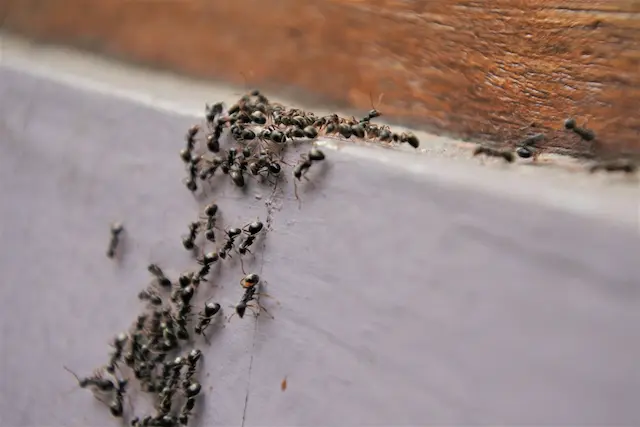Ah, the subtle indicators of a home invasion – but this time it’s not your neighbor’s inquisitive cat snooping around. A potential infestation of carpenter ants is similarly covert but considerably more concerning. These clever creatures may not have blueprints, but they are experts at compromising the structural integrity of your home. So, let’s delve into the world of carpenter ant infestations and discover how to identify early warning signs before your wooden sanctuary becomes their empire.
The woodworkers of the Kingdom of Ants
Let’s begin by identifying the perpetrators: carpenter ants. These are not your average ants; they are larger and typically black, with variable red and brown hues. In contrast to termites, they do not utilize wood for food; instead, they prefer to hollow it out to construct their nests. These industrious insects can compromise the structural integrity of wooden structures if left unchecked, making early identification crucial.
The Frass Indicia
Frass is one of the telltale indications of a carpenter ant infestation. What do you think? It is a fanciful term for the fine sawdust-like material that carpenter ants excavate from wood as they leave their galleries. Frass mounds near wooden structures, such as window sills or baseboards, are a strong indication that these ants have established a nest.
The Rattling Sounds
Have you ever heard a subtle rustling from your walls or ceilings? It is likely the sound of carpenter termites at work, and not your imagination. As these ants create their nests in wood, they may generate sounds that may catch your attention, particularly during the night’s quiet hours. Therefore, if you are ever in your living room and hear what sounds like a miniature construction workforce, you should investigate.
The Telling Signs
Carpenter ants have a long history of constructing well-organized foraging trails. Pay attention if you observe a line of ants parading back and forth in your residence. Although these trails may not directly lead to a nest, they undoubtedly indicate the presence of these woodworkers in the area. If you follow the trace, you may find the source of the infestation.
Wingless Travellers
The apparition of winged individuals, also known as swarmers, is an additional indication of a carpenter ant infestation. These winged ants are not out to wreak havoc like their labourer counterparts; instead, they are searching for new nesting sites. This is a distinct indication that a nearby carpenter ant colony has reached maturity and is ready to produce swarmers.
Access to the Nest
Occasionally, the greatest clues are immediately in front of you or above you. Nests of carpenter ants frequently feature small apertures or “windows” on the surface of the wood. These entrances and exits can be a significant indication. If you find a small cavity in a wooden structure and suspect an infestation, don’t simply patch it; it may conceal a complex network of carpenter ant tunnels.
Early identification is your secret weapon in the fight against carpenter ant infestations. By remaining vigilant for frass, listening for rustling sounds, observing foraging trails, keeping an eye out for winged swarmers, and inspecting for enigmatic “windows,” you can defeat these wood-loving invaders. Remember, your residence is your sanctuary, so it’s important to maintain it.

